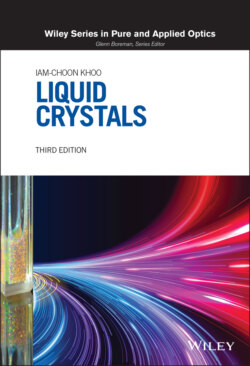Читать книгу Liquid Crystals - Iam-Choon Khoo - Страница 46
3.3.1. DC and Low‐frequency Dielectric Permittivity, Conductivities, and Magnetic Susceptibility
ОглавлениеThe dielectric constant ε is defined by the Maxwell equation [5]:
(3.15a)
where is the displacement current, is the electric field, and is the tensor. For a uniaxial nematic liquid crystal, we have
(3.15b)
Equations (3.15a) and (3.15b) yield, for the two principal axes,
(3.16)
and
(3.17)
Typical values of ε|| and ε⊥ are on the order of 5ε0, where ε0 is the permittivity of free space. Similarly, the electric conductivities σ|| and σ⊥ of nematics are defined by
(3.18)
and
(3.19)
where J∥ and J⊥ are the currents flowing along and perpendicularly to the director axis, respectively. In conjunction with an applied dc electric field, the conductivity anisotropy could give rise to space charge accumulation and create strong director axis reorientation in a nematic film, giving rise to an orientational photorefractive [6] effect (see Chapter 8).
Most nematics (e.g. E7, pentyl cyanobiphenyl [5CB], etc.) are said to possess positive (dielectric) anisotropy (ε|| > ε⊥). On the other hand, some nematics, such as MBBA, possess negative anisotropy (i.e. ε|| < ε⊥). The controlling factors are the molecular constituents and structures.
In general, ε|| and ε⊥ have different dispersion regions, as shown in Figure 3.4 for 4‐methoxy‐4′‐n‐butylazoxy‐benzene [7], which possess negative dielectric anisotropy (Δε < 0). Also plotted in Figure 3.4 is the dispersion of εiso, the dielectric constant for the isotropic case. Notice that for frequencies of 109 Hz or less, ε⊥ > ε||. At higher frequencies and in the optical regime, ε|| > ε⊥ (i.e. the dielectric anisotropy changes sign).
For some nematic liquid crystals, this changeover in the sign of Δε = ε|| − ε⊥ occurs at a much lower frequency (cf. Figure 3.5 for phenylbenzoates [8]). This changeover frequency fco is lower because of the long three‐ringed molecular structure, which is highly resistant to the rotation of molecules around the short axes.
Figure 3.4. Dispersion data of the dielectric constant ε|| and ε⊥ for the nematic and isotropic phase of the liquid crystal 4‐methoxy‐4′‐n‐butylazoxy‐benzene.
Figure 3.5. Dispersion data of the dielectric constant ε|| and ε⊥ for the nematic and isotropic phase of the liquid crystal phenylbenzoate.
For electro‐optical applications, the dielectric relaxation behavior of ε|| and ε⊥ for the different classes of nematic liquid crystals, and the relationships between the molecular structures and the dielectric constant, is obviously very important. This topic, however, is beyond the scope of this chapter, and the reader is referred to Blinov [8] and Khoo and Wu [9] and the references quoted therein for more detailed information.
Pure organic liquids are dielectric (i.e. nonconducting [σ = 0]). The electric conductivities of liquid crystals are due to some impurities or ions. In general, σ|| is larger than σ⊥. Electrical conduction plays an important role in electro‐optical applications of liquid crystals in terms of stability and instability, chemical degradation, and lifetime of the device [9]. Typically, σ|| and σ⊥ are on the order of 10−10 S−1 cm−1 for pure nematics. As in almost all materials, these conductivities could be varied by several orders of magnitude with the use of appropriate dopants.
The magnetic susceptibility of a material is defined in terms of the magnetization , the magnetic induction , and the magnetic strength by
(3.20)
and
(3.21)
The magnetic susceptibility tensor is anisotropic. For a uniaxial material such as a nematic, the magnetic susceptibility takes the form
(3.22)
Note that this is similar to the dielectric constant .
Nematic liquid crystals, in fact, liquid crystals in general, are diamagnetic. Therefore, and are negative of vanishingly small magnitude. As a result of the smallness of these magnetic susceptibilities, the magnetic interactions among the molecules comprising the liquid crystal are small (in comparison with their interaction with the externally applied field). Consequently, the local field acting on the molecules differs very little from the external field, and in general, magnetic measurements are the preferred method to study liquid crystal order parameters and other physical processes.
